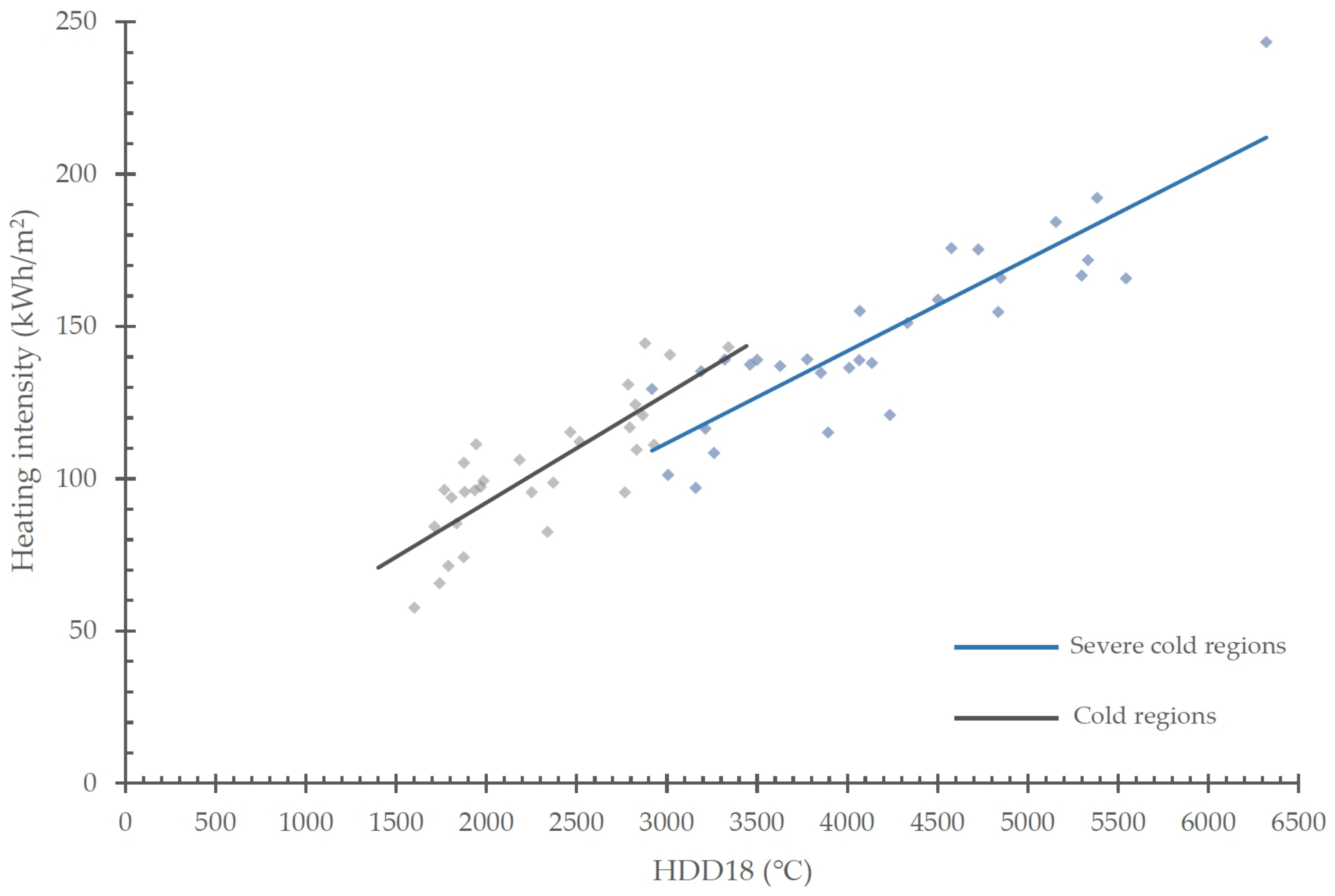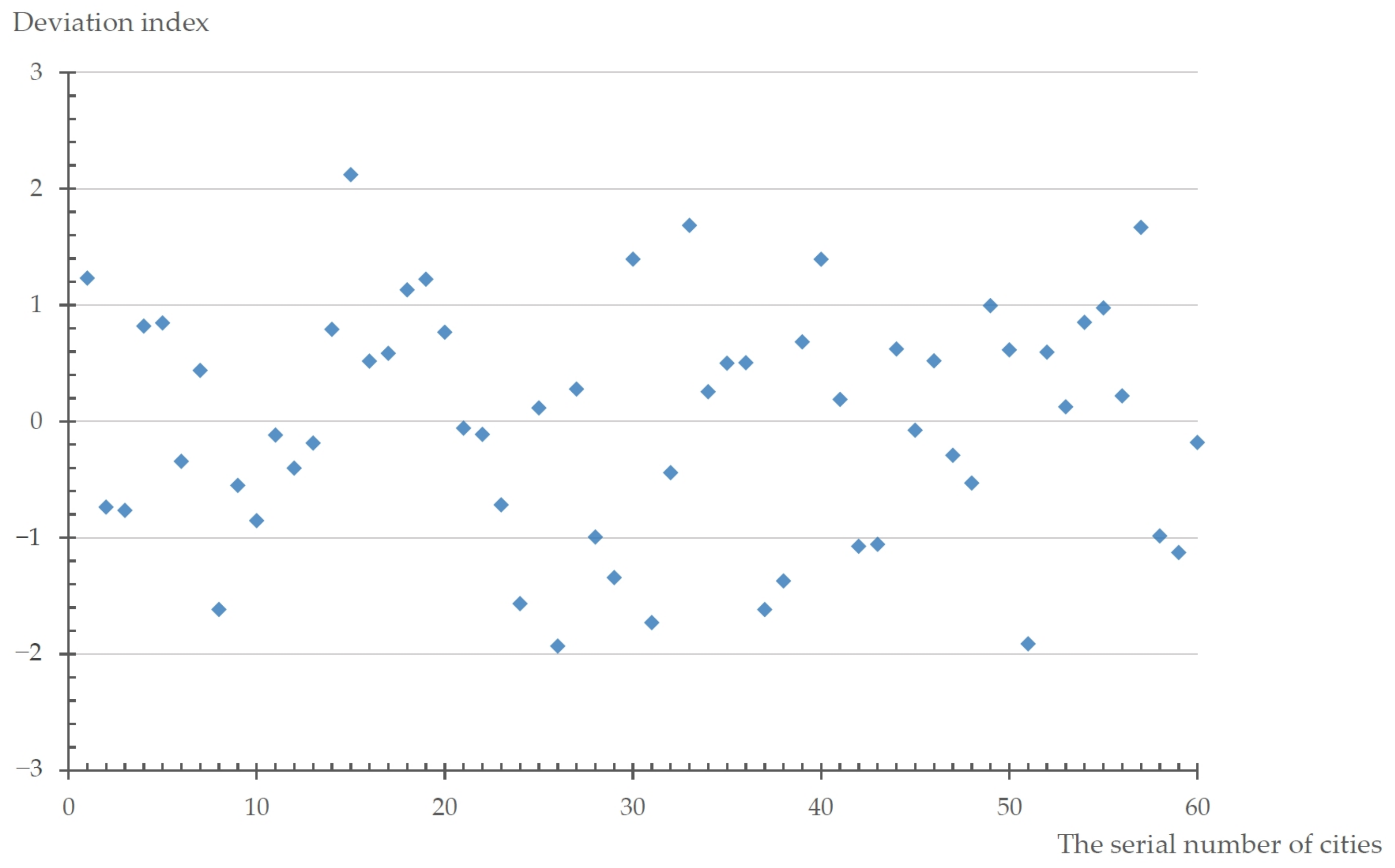Using the Degree-Day Method to Analyze Central Heating Energy Consumption in Cities of Northern China
Abstract
:1. Introduction
2. Materials and Methods
2.1. Target Cities and Data Collection
| Climate Regions | Name of Target Cities |
|---|---|
| Severe cold regions | Altay, Baotou, Benxi, Changchun, Dunhua, Golmud, Hailin, Hami, Harbin, Heihe, Hezuo, Hohhot, Holingol, Huadian, Hulunbuir, Hunchun, Jayuguan, Qitaihe, Shenyang, Shuozhou, Songyuan, Urumqi, Xilinhot, Xining, Yichun, Yining, Yulin, Yushu, Zhangjiakou, Zhangye |
| Cold regions | Anyang, Baoji, Beijing, Cangzhou, Changyi, Changzhi, Dalian, Gaizhou, Guyuan, Jiaozuo, Jinan, Jinzhou, Kashi, Lanzhou, Liaocheng, Linfen, Linyi, Lvliang, Qingdao, Sanmenxia, Shijiazhuang, Taiyuan, Tangshan, Tianjin, Wuan, Wuwei, Xian, Yinchuan, Zhengzhou, Zhongwei |
2.2. Establishment and Evaluation of Predictive Model
2.3. Calculation of Base Temperatures
2.4. Deviation Index and City Classification
3. Results
3.1. Model Equations and Accuracy
3.2. Result of Actual Base Temperatures
3.3. Analysis of Heating Characteristics in Different Categories of Cities
4. Discussion
5. Conclusions
Supplementary Materials
Author Contributions
Funding
Institutional Review Board Statement
Informed Consent Statement
Data Availability Statement
Conflicts of Interest
References
- Cao, X.; Dai, X.; Liu, J. Building energy-consumption status worldwide and the state-of-the-art technologies for zero-energy buildings during the past decade. Energy Build. 2016, 128, 198–213. [Google Scholar] [CrossRef]
- Yuan, T.; Zhu, N.; Shi, Y.; Chang, C.; Yang, K.; Ding, Y. Sample data selection method for improving the prediction accuracy of the heating energy consumption. Energy Build. 2018, 158, 234–243. [Google Scholar] [CrossRef]
- Cabeza, L.F.; Rincon, L.; Vilarino, V.; Perez, G.; Castell, A. Life cycle assessment (LCA) and life cycle energy analysis (LCEA) of buildings and the building sector: A review. Renew. Sustain. Energy Rev. 2014, 29, 394–416. [Google Scholar] [CrossRef]
- Yu, Y.; Cheng, J.; You, S.; Ye, T.; Zhang, H.; Fan, M.; Wei, S.; Liu, S. Effect of implementing building energy efficiency labeling in China: A case study in Shanghai. Energy Policy 2019, 133, 110898. [Google Scholar] [CrossRef]
- Chen, Y.; Li, M.; Xiong, M.; Cao, J.; Li, J. Future Climate Change on Energy Consumption of Office Buildings in Different Climate Zones of China. Pol. J. Environ. Stud. 2018, 27, 45–53. [Google Scholar] [CrossRef]
- Liu, J.; He, Z.; Yang, L. Classification of China cold climate and the strategy in architectural thermal design. J. Xi’an Univ. Archit. Technol. 2020, 52, 309–314. [Google Scholar] [CrossRef]
- Tsinghua University. Annual Report on China Building Energy Efficiency; China Architecture & Building Press: Beijing, China, 2019. [Google Scholar]
- Jiang, Y. Research on energy efficient retrofit problems of existing buildings in northern heating area. Energy China 2011, 33, 6–13+35. [Google Scholar] [CrossRef]
- Zhang, Y.; Liu, X.; Qin, B. Energy saving operation optimization in urban district heating system: A case study. Heat. Vent. Air Cond. 2015, 45, 97–100. [Google Scholar]
- Wang, S.; Li, Y.; Hague, M. Evidence on the Impact of Winter Heating Policy on Air Pollution and Its Dynamic Changes in North China. Sustainability 2019, 11, 2728. [Google Scholar] [CrossRef]
- Zhou, Z.; Wang, C.; Sun, X.; Gao, F.; Feng, W.; Zillante, G. Heating energy saving potential from building envelope design and operation optimization in residential buildings: A case study in northern China. J. Clean. Prod. 2018, 174, 413–423. [Google Scholar] [CrossRef]
- Zhang, Y.; He, C.; Tang, B.; Wei, Y. China’s energy consumption in the building sector: A life cycle approach. Energy Build. 2015, 94, 240–251. [Google Scholar] [CrossRef]
- Zhang, L.; Li, Y.; Zhang, H.; Xu, X.; Yang, Z.; Xu, W. A review of the potential of district heating system in Northern China. Appl. Therm. Eng. 2021, 188, 116605. [Google Scholar] [CrossRef]
- Yuan, J.; Huang, K.; Han, Z.; Zhou, Z.; Lu, S. A new feedback predictive model for improving the operation efficiency of heating station based on indoor temperature. Energy 2021, 222, 119961. [Google Scholar] [CrossRef]
- Liu, Y.; Cao, Y. Development and research on energy performance assessment method of heat-exchanging stations based on real data. Sustain. Cities Soc. 2020, 59, 102188. [Google Scholar] [CrossRef]
- Lin, B.; Lin, J. Evaluating energy conservation in China’s heating industry. J. Clean. Prod. 2017, 142, 501–512. [Google Scholar] [CrossRef]
- Liu, G.; Kong, Z.; Dong, J.; Dong, X.; Jiang, Q.; Wang, K.; Li, J.; Li, C.; Wan, X. Influencing Factors, Energy Consumption, and Carbon Emission of Central Heating in China: A Supply Chain Perspective. Front. Energy Res. 2021, 9, 648857. [Google Scholar] [CrossRef]
- Wang, D.; Zhang, R.; Luo, X.; Men, R.; Liu, Y.; Liu, J. Energy consumption characteristics and carbon saving potential of central heating in typical cities in Northwest China. J. Xi’an Univ. Archit. Technol. 2022, 54, 819–826+837. [Google Scholar] [CrossRef]
- De Rosa, M.; Bianco, V.; Scarpa, F.; Tagliafico, L.A. Heating and cooling building energy demand evaluation; a simplified model and a modified degree days approach. Appl. Energy 2014, 128, 217–229. [Google Scholar] [CrossRef]
- De Rosa, M.; Bianco, V.; Scarpa, F.; Tagliafico, L.A. Historical trends and current state of heating and cooling degree days in Italy. Energy Convers. Manag. 2015, 90, 323–335. [Google Scholar] [CrossRef]
- Salem, H.; Khanafer, K.; Alshammari, M.; Sedaghat, A.; Mahdi, S. Cooling Degree Days for Quick Energy Consumption Estimation in the GCC Countries. Sustainability 2022, 14, 13885. [Google Scholar] [CrossRef]
- D’Amico, A.; Ciulla, G.; Panno, D.; Ferrari, S. Building energy demand assessment through heating degree days: The importance of a climatic dataset. Appl. Energy 2019, 242, 1285–1306. [Google Scholar] [CrossRef]
- Kohler, M.; Blond, N.; Clappier, A. A city scale degree-day method to assess building space heating energy demands in Strasbourg Eurometropolis (France). Appl. Energy 2016, 184, 40–54. [Google Scholar] [CrossRef]
- Jiang, D.; Xiao, W.; Wang, J.; Wang, H.; Zhao, Y.; Li, B.; Zhou, P. Evaluation of the effects of one cold wave on heating energy consumption in different regions of northern China. Energy 2018, 142, 331–338. [Google Scholar] [CrossRef]
- Ministry of Housing and Urban Rural Development. China Urban Construction Statistical YEARBOOK (2019); China Planning Press: Beijing, China, 2020. [Google Scholar]
- China Meteorological Administration. National Meteorological Science Data Center. Available online: http://data.cma.cn/site/index.html (accessed on 6 September 2022).
- GB 50176-2016; Thermal Design Code for Civil Building. China Architecture & Building Press: Beijing, China, 2016.
- Shen, X.; Liu, B. Changes in the timing, length and heating degree days of the heating season in central heating zone of China. Sci. Rep. 2016, 6, 33384. [Google Scholar] [CrossRef]
- Quayle, R.G.; Diaz, H.F. Heating degree-day data applied to residential heating energy-consumption. J. Appl. Meteorol. Climatol. 1980, 19, 241–246. [Google Scholar] [CrossRef]
- Fumo, N.; Biswas, M.A.R. Regression analysis for prediction of residential energy consumption. Renew. Sustain. Energy Rev. 2015, 47, 332–343. [Google Scholar] [CrossRef]
- Sha, H.; Xu, P.; Hu, C.; Li, Z.; Chen, Y.; Chen, Z. A simplified HVAC energy prediction method based on degree-day. Sustain. Cities Soc. 2019, 51, 101698. [Google Scholar] [CrossRef]
- Park, S.; Shim, J.; Song, D. Issues in calculation of balance-point temperatures for heating degree-days for the development of building-energy policy. Renew. Sustain. Energy Rev. 2021, 135, 110211. [Google Scholar] [CrossRef]
- Lee, K.; Baek, H.-J.; Cho, C. The Estimation of Base Temperature for Heating and Cooling Degree-Days for South Korea. J. Appl. Meteorol. Climatol. 2014, 53, 300–309. [Google Scholar] [CrossRef]
- Mourshed, M. Relationship between annual mean temperature and degree-days. Energy Build. 2012, 54, 418–425. [Google Scholar] [CrossRef]
- Buyukalaca, O.; Bulut, H.; Yilmaz, T. Analysis of variable-base heating and cooling degree-days for Turkey. Appl. Energy 2001, 69, 269–283. [Google Scholar] [CrossRef]
- Jiang, Y. Concept Debate for China’s Building Energy Conservation; China Architecture & Building Press: Beijing, China, 2016. [Google Scholar]
- Du, T.; Huang, K.; Zhou, Z.; Sun, X.; Feng, W.; Zuo, J. Analysis on present situation and energy saving potential of heating energy consumption of residential buildings in Chinese northern cities. Heat. Vent. Air Cond. 2016, 46, 75–81. [Google Scholar]
- Nobre, J.S.; Singer, J.d.M. Residual analysis for linear mixed models. Biom. J. 2007, 49, 863–875. [Google Scholar] [CrossRef]
- Zhao, R.; Fang, C.; Liu, J.; Zhang, L. The evaluation and obstacle analysis of urban resilience from the multidimensional perspective in Chinese cities. Sustain. Cities Soc. 2022, 86, 104160. [Google Scholar] [CrossRef]
- Chang, C.; Zhu, N.; Yang, K.; Yang, F. Data and analytics for heating energy consumption of residential buildings: The case of a severe cold climate region of China. Energy Build. 2018, 172, 104–115. [Google Scholar] [CrossRef]
- Xia, J.; Zhang, Y. Research on the current situation and typical issues of heating in small towns of northern China. Dist. Heat. 2018, 1, 39–43. [Google Scholar] [CrossRef]
- Tian, X.; Xu, J.; Li, N.; Qiu, Y. Current Status and Outlook of Building Energy Conservation Development in Beijing City. Constr. Sci. Technol. 2017, 8, 17–19+33. [Google Scholar] [CrossRef]





| Population Size | Ten-Years Investment | Geographical Regions | |||
|---|---|---|---|---|---|
| Scale (Thousand) | Number | Level (Million CNY) | Number | Region | Number |
| Small city Population < 500 | 17 | Class D Investment < 500 | 16 | Northeast China | 17 |
| Medium city 500 ≤ Population < 1000 | 16 | Class C 500 ≤ Investment < 1500 | 13 | Northwest China | 19 |
| Big city 1000 ≤ Population < 5000 | 16 | Class B 1500 ≤ Investment < 5000 | 14 | North China | 15 |
| Super-/mega-sized city Population ≥ 5000 | 11 | Class A Investment ≥ 5000 | 15 | Central China | 9 |
| Piece-Wise Model | Evaluation Indices | |||
|---|---|---|---|---|
| Climate Classification | Equations | R2 | CV-RMSE | p-Value |
| Severe cold regions | y = 0.0302x + 21.027 | 0.767 | 9.684% | 0.000 |
| Cold regions | y = 0.0357x + 20.769 | 0.666 | 12.020% | 0.000 |
| City Ranking (from the Lowest) | Deviation Index | City Scale | Investment Level |
|---|---|---|---|
| 1. Urumqi | −1.932 | Big city | Class A |
| 2. Taiyuan | −1.913 | Super/mega-sized city | Class A |
| 3. Beijing | −1.729 | Super/mega-sized city | Class A |
| 4. Zhengzhou | −1.618 | Super/mega-sized city | Class B |
| 5. Changchun | −1.617 | Super/mega-sized city | Class A |
Disclaimer/Publisher’s Note: The statements, opinions and data contained in all publications are solely those of the individual author(s) and contributor(s) and not of MDPI and/or the editor(s). MDPI and/or the editor(s) disclaim responsibility for any injury to people or property resulting from any ideas, methods, instructions or products referred to in the content. |
© 2024 by the authors. Licensee MDPI, Basel, Switzerland. This article is an open access article distributed under the terms and conditions of the Creative Commons Attribution (CC BY) license (https://creativecommons.org/licenses/by/4.0/).
Share and Cite
Song, Y.; Du, A.; Cui, T. Using the Degree-Day Method to Analyze Central Heating Energy Consumption in Cities of Northern China. Sustainability 2024, 16, 1008. https://doi.org/10.3390/su16031008
Song Y, Du A, Cui T. Using the Degree-Day Method to Analyze Central Heating Energy Consumption in Cities of Northern China. Sustainability. 2024; 16(3):1008. https://doi.org/10.3390/su16031008
Chicago/Turabian StyleSong, Yangyi, Ao Du, and Tong Cui. 2024. "Using the Degree-Day Method to Analyze Central Heating Energy Consumption in Cities of Northern China" Sustainability 16, no. 3: 1008. https://doi.org/10.3390/su16031008





